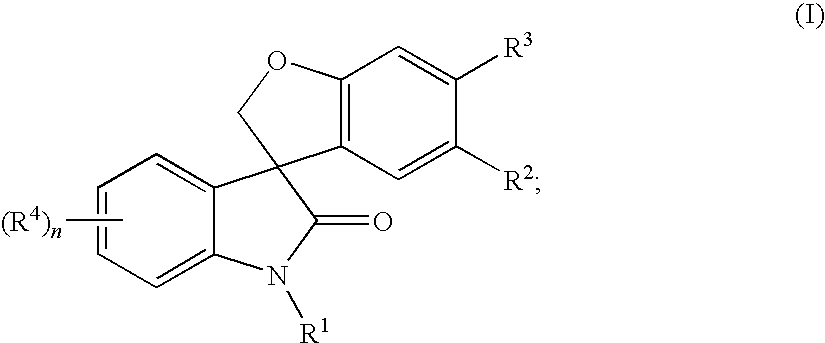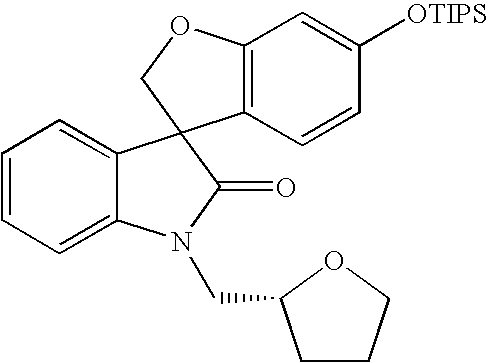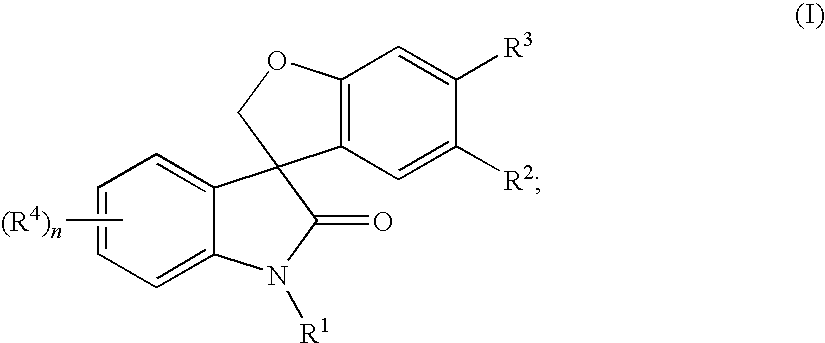Spiro-oxindole compounds and their use as therapeutic agents
a technology of spiro-oxindole and compound, which is applied in the direction of biocide, cardiovascular disorder, drug composition, etc., can solve the problems of major pathophysiological conditions, major changes, and insufficient potency and therapeutic index of spiro-oxindole, so as to increase the potency of existing or future drug therapy and reduce adverse events
- Summary
- Abstract
- Description
- Claims
- Application Information
AI Technical Summary
Benefits of technology
Problems solved by technology
Method used
Image
Examples
preparation 1
Synthesis of 3-[4-(benzyloxy)-2-hydroxyphenyl]-1-(diphenylmethyl)-1,3-dihydro-2H-indol-2-one
A. Synthesis of 3-[4-(benzyloxy)-2-hydroxyphenyl]-1-(diphenylmethyl)-3-hydroxy-1,3-dihydro-2H-indol-2-one
[0455]To a stirred solution of 3-(benzyloxy)phenol (8.7 g, 43.5 mmol) in tetrahydrofuran (100 mL) was added iso-propylmagnesium chloride (22.7 mL, 2 M tetrahydrofuran solution, 45.4 mmol) slowly at 0° C. The mixture was allowed to stir at 0° C. for 30 min, and concentrated in vacuo to dryness. Dichloromethane (100 mL) was added, followed by the addition of a solution of 1-(diphenylmethyl)-1H-indole-2,3-dione (12.4 g, 39.5 mmol) in dichloromethane (50 mL) at 0° C. The mixture was stirred at ambient temperature for 16 h, and quenched with saturated ammonium chloride solution. The organic layer was washed with water, dried over sodium sulfate and filtered. The filtrate was concentrated in vacuo to dryness. The obtained solid was recrystallized from ethyl acetate / hexanes to afford 3-[4-(benzyl...
preparation 2
Synthesis of 3-(4-bromo-2-hydroxyphenyl)-1-(diphenylmethyl)-1,3-dihydro-2H-indol-2-one
A. Synthesis of 3-(4-bromo-2-hydroxyphenyl)-1-(diphenylmethyl)-3-hydroxy-1,3-dihydro-2H-indol-2-one
[0457]To a stirred solution of 3-bromophenol (11.9 g, 69.2 mmol) in dichloromethane (160.0 mL) at 0° C. was added isopropylmagnesium chloride (2.0 M in tetrahydrofuran, 38.0 mL, 76.1 mmol). The solution was stirred at 0° C. for 30 min, then 1-benzhydrylindoline-2,3-dione (10.0 g, 34.6 mmol) was added. The reaction was stirred at ambient temperature for 16 h, then concentrated in vacuo to dryness. The residue obtained was dissolved in ethyl acetate (400.0 mL) and washed with saturated ammonium chloride solution (3×100.0 mL). The organic phase was dried over magnesium sulfate, filtered and concentrated in vacuo to dryness. Purification by flash chromatography with 30% ethyl acetate in hexanes afforded 3-(4-bromo-2-hydroxyphenyl)-1-(diphenylmethyl)-3-hydroxy-1,3-dihydro-2H-indol-2-one (11.7 g, 70%) as a ...
preparation 3
Synthesis of 6-(benzyloxy)-1′-(diphenylmethyl)spiro[1-benzofuran-3,3′-indol]-2′(1′H)-one
[0459]To a stirred solution of 3-[4-(benzyloxy)-2-hydroxyphenyl]-1-(diphenylmethyl)-1,3-dihydro-2H-indol-2-one (7.4 g, 14.8 mmol), chloroiodomethane (2.7 mL, 37.0 mmol) in anhydrous tetrahydrofuran (200 mL) was added cesium carbonate (15.4 g, 47.4 mmol) under argon. The mixture was stirred at ambient temperature for 16 h, then filtered through a pad of celite. The filtrate was concentrated under vacuum. The residue was purified by column chromatography (ethyl acetate / hexanes, 1 / 5) followed by the treatment with diethyl ether / hexanes to afford 6-(benzyloxy)-1′-(diphenylmethyl)spiro[1-benzofuran-3,3′-indol]-2′(1′H)-one (4.1 g, 55%) as a colorless solid: 1H NMR (300 MHz, CDCl3) δ 7.42-7.25 (m, 15H), 7.16-7.09 (m, 1H), 7.07-6.90 (m, 3H), 6.62-6.38 (m, 4H), 5.03-4.90 (m, 3H), 4.73 (d, J=9.0 Hz, 1H); MS (ES+) m / z 510.1 (M+1).
PUM
| Property | Measurement | Unit |
|---|---|---|
| body weight | aaaaa | aaaaa |
| temperature | aaaaa | aaaaa |
| pressure | aaaaa | aaaaa |
Abstract
Description
Claims
Application Information
 Login to View More
Login to View More - R&D
- Intellectual Property
- Life Sciences
- Materials
- Tech Scout
- Unparalleled Data Quality
- Higher Quality Content
- 60% Fewer Hallucinations
Browse by: Latest US Patents, China's latest patents, Technical Efficacy Thesaurus, Application Domain, Technology Topic, Popular Technical Reports.
© 2025 PatSnap. All rights reserved.Legal|Privacy policy|Modern Slavery Act Transparency Statement|Sitemap|About US| Contact US: help@patsnap.com



